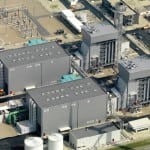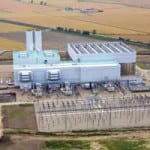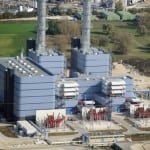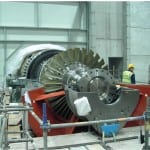There’s nothing slow about the fast-track operations at the new 870-MW Sloe Centrale Power Plant. The combined-cycle plant is designed for 250 starts per year and is capable of supplying power to the grid within a mere 30 to 40 minutes. In addition to its impressive rapid load response, the gas-fired plant produces low CO2 and NOx emissions by using the latest technology. It also attains an efficiency of 59%.
Well-known for conquering the sea in order to reclaim land, the Dutch people have been very successful in their reclamation efforts in the Zeeland province. In fact, the new Sloe Centrale Power Plant was built near the existing port and industrial area of Vlissingen East, which was created by reclamation of the South Sloe waterway.
The Sloe Centrale plant’s technical achievements are no doubt particularly appreciated by the Dutch people, whose engineering prowess is apparent in the many polders (land reclaimed by the building of dikes) in the region. The facility consists of two units each supplying 435 MW and meets the most stringent European Union environmental requirements. It attains an efficiency of 59% and thus has very low carbon dioxide (CO2) emissions. Due to state-of-the-art burner technology, the plant’s nitrogen oxide (NOx) emissions are very low: <15 ppm, which is about 40% less than those typically generated by conventional fossil fuel plants. The new plant’s CO2 emissions are approximately 25% lower than emissions from conventional fossil plants. The plant is designed for 250 starts per year and is capable of supplying power to the grid within a mere 30 to 40 minutes.
Combined-cycle power plants (CCPPs) such as the Sloe Centrale facility are providing an increasingly larger share of the electric power generated in Europe. The growing contribution of CCPPs to power generation over the past decade can be explained by their high efficiency, short start-up time, and relatively low investment costs, according to Lothar Balling, vice president of Energy Solutions Europe in the Fossil Power Division of Siemens Energy, Germany.
Siemens Energy, the contractor, began constructing the Sloe plant in 2007. It handed over the completed CCPP to the joint venture of Delta Energy B.V., Netherlands and EDF, France at the end of 2009. Immediately thereafter, the facility went online. It supplies electricity to both industrial and residential customers. With an installed capacity of 870 MW, the plant will produce power to meet the needs of more than 2 million Dutch households.
The Dutch Electric Power Industry
A modern, industrialized nation with a population that exceeds 16 million residents, the Netherlands is also a large exporter of agricultural products, according to the U.S. Central Intelligence Agency’s (CIA) World Factbook. According to the CIA’s research, estimates of 2008 electricity production and consumption in the Netherlands were approximately 108.2 billion kWh and 124.1 billion kWh, respectively. Recent statistics also show that the Netherlands annually exports approximately 10.86 billion kWh of electricity and imports about 15.45 billion kWh (2009 estimates).
Plant Profile
Sloe Centrale Power Plant is composed of two single-shaft plants, in which the main components are arranged on a single driveline (Figure 1). Siemens built the plant as a turnkey project and supplied the main components: two SGT5-4000F gas turbines, two SST5-5000 steam turbines, two hydrogen-cooled generators, and the entire electrical and SPPA-T3000 instrumentation and control equipment.
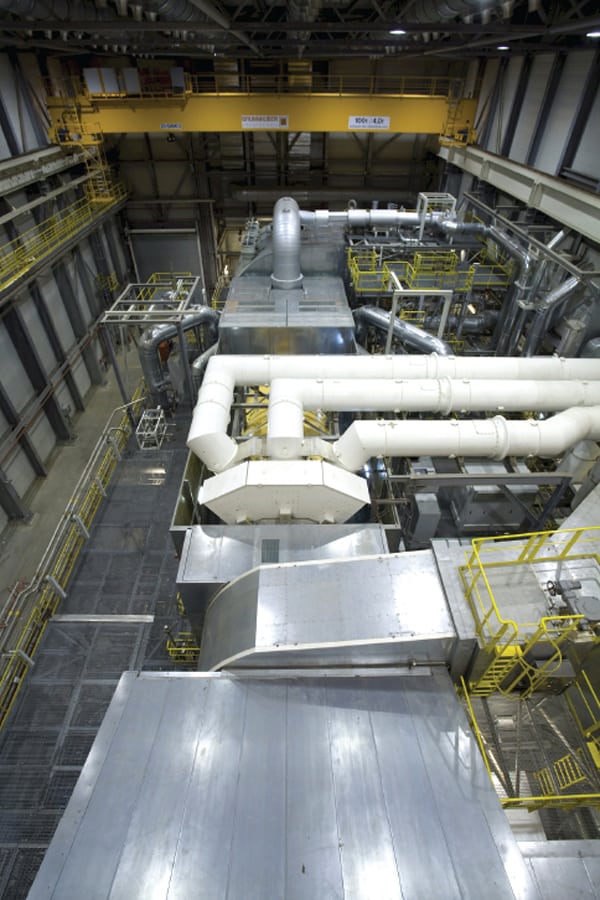 |
| 1. All lined up. This interior view of the Sloe Centrale combined-cycle plant shows the gas turbine, generator, and steam turbine arranged on a single shaft. Courtesy: Siemens Energy |
The facility also uses once-through Benson-type boilers. The advantages of this type of boiler are many: its design minimizes limitations due to thermal stresses, it facilitates very high cycling, it reduces start-up time; and it is proven technology for coal-fired power plants, and recently was adapted for use with combine-cycle gas turbines.
Natural gas burned in the gas turbine results in very low NOx and CO2 emissions, and the exhaust gas is then passed through a boiler. In the boiler, the heat of the exhaust gas causes steam to be produced. This steam is then led through a steam turbine. Together, the gas and steam turbines drive the generator. This very effective use of residual heat from the gas turbine’s exhaust makes Sloe Centrale a highly efficient combined-cycle plant.
Steam from the steam turbine exhaust is cooled by seawater in the condenser. Finally, the electricity is transmitted through an underground transmission cable to a distribution plant.
The plant uses natural gas transported and supplied by Gasunie Transport Service and Fluxys, which is based in Belgium. These companies obtain their natural gas from diverse sources: the Netherlands, Norway, the United Kingdom, Russia, and the liquefied natural gas–producing countries (primarily Qatar).
During construction, the plant provided work for an estimated 700 workers. Since the plant was put into operation, approximately 40 people keep it running. Siemens’ fast-cycling concept allows a fully automated start-up and shutdown, which reduces the time and operator workload required during these evolutions.
The construction and maintenance contract totaled €550 million. Siemens Netherlands was contracted for maintenance of the facility.
Providing Balance to Fluctuating Renewables
The design team had three key design drivers for the facility: flexibility, reliability, and efficiency. For example, one of important purposes of this plant is to provide electricity during periods when renewable sources such as solar and wind power produce intermittent amounts of electricity due to changing weather conditions.
“Renewable and discontinuous power generation technologies such as wind and solar power are increasingly penetrating the European electric power market,” Balling said. “Renewable resources certainly are leading the way to reduced CO2 emissions in Europe; however, on the other hand, their limited availability and predictability pose a considerable challenge to grid stability.”
Periods of low generation from renewable sources due to weather conditions (low winds, overcast skies, and day/night cycles) have to be covered by other types of power generation such as fossil-fired power plants, explained Balling. As a result, the requirements related to operational flexibility and rapid load response of the existing and new-built fossil fleet, as formulated in grid codes and customer specifications, are constantly increasing. These grid code and customer specification changes drive modern power plant design to place a strong focus on operational flexibility and grid support operation.
Fast Cycling: The Need for Speed
In recent years, the demand for quicker start-ups at CCPPs soon followed the demand for more frequent start-ups, Balling explained. This market demand finally resulted in the launch of a development project by Siemens that combined all the initial engineering ideas into a single integrated plant concept called FACY (derived from FAst CYcling). The aim of the subsequently initiated research and development program was to design a plant for an increased number of starts and to reduce start-up times. If possible, no limits were to be placed on the gas turbine by other power plant components, such as the heat-recovery steam generator or steam turbine, during hot and warm starts.
During the course of the project, potential areas came to light in which further optimization could be achieved, although these had to wait for a second development generation to be implemented. The major improvement offered by this second generation involved the start-up procedure, according to Balling. “Hold points,” which are stages at which plant personnel had to wait until certain steam parameters had been reached before the start-up process could begin, were eliminated as part of the shortened “start on the fly” start-up procedure. With second-generation FACY plants, the steam turbine is started up in parallel with the gas turbine using the first steam that becomes available after a hot start. Whereas the first-generation FACY plants reduced start-up times for a hot start from 100 to 55 minutes, second-generation FACY plants succeeded in pushing start-up times down below the 40-minute mark for an output of 850 MW.
“The Sloe Centrale plant was one of the first plants in commercial operation that incorporated the advantages of both the first and second generations of the FACY concept,” Balling said. “During its acceptance tests that achieved more than 59% net efficiency, the Sloe Centrale plant recorded impressive 30-minute start-up times. Equally good results have been exhibited by other reference plants. This means that the expectations placed on the second generation of FACY have been far surpassed in a number of cases.”
Winning Combination
The Sloe Centrale Power Plant promises to provide an abundant, reliable source of electricity with low emissions to the citizens of Zeeland Province well into the future.
“The new power plant impressively shows how security of supply, cost-effectiveness, and environmental compatibility can be harmonized,” Balling said.
— Angela Neville, JD, is POWER’s senior editor.







